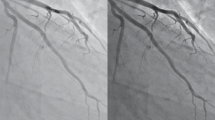Abstract
Using the method of local hydrogen clearance according to Lübbers and Stosseck [1], hydrogen is electrochemically generated for about 1 s by one electrode, and the hydrogen pressure,p (t), is polarographically measured by another electrode located at a distance of about 300 μm. For the evaluation of the local clearance R. Wodick could show that the time,t m, of the maximum of the curve,y(t)=p(t)·t 2/3, is inversely proportional to the mean flow velocity,\(\bar v\). So we obtain\(t_m = \frac{a}{{\bar v}} [6]\). But for practical application further development of the evaluation method was necessary. The determination of the mean flow velocity,\(\bar v\), by measurementt m was improved by including several points of the curvey(t): t m can also be found from the geometrical mean of pairs of equaly(ti)=y(ti *):
In the case of in situ application, considerable disturbances must be taken into account, e.g., the movement of the heart muscle. The influence of these disturbances was reduced (1) by applying an RC filter and a proper correction of the time constant (2) by using an on-line multiplication unit.
By special application of the theory 2 new ways of valuation were found.\(\bar v\) can be determined (1) from the gravity center ofp(t), or (2) from a hydrogen desaturation curve taking “height over area”.
Some test experiments on the beating rabbit heart in situ proved the practial applicability of the methods.
Similar content being viewed by others
References
Lübbers, D. W., Stosseck, K.: Quantitative Bestimmung der lokalen Durchblutung durch elektrochemisch im Gewebe erzeugten Wasserstoff. Naturwissenschaften57, 311–312 (1970)
Mikusinski, J.: Operatorenrechnung. Berlin: VEB Deutscher Verlag der Wissenschaften 1957
Stosseck, K., Lübbers, D. W., Cottin, N.: Determination of local blood flow (microflow) by electrochemically generated hydrogen. Pflügers Arch.348, 225–238 (1974)
Wodick, R.: Compensation of measuring errors produced by finite response time in polarographic measurements with electrodes sensitive to oxygen and hydrogen. Pflügers Arch.336, 327–344 (1972)
Wodick, R.: Möglichkeiten und Grenzen der Bestimmung der Blutversorgung mit Hilfe der lokalen Wasserstoffclearance. Habil.-Schrift Bochum (1973)
Wodick, R.: Möglichkeiten und Grenzen der Bestimmung der Blutversorgung mit Hilfe der lokalen Wasserstoffclearance. Akademie der Wissenschaften und der Literatur, Mainz. Wiesbaden: Steiner 1976
Author information
Authors and Affiliations
Rights and permissions
About this article
Cite this article
Wodick, R., Lübbers, D.W., Grossmann, U. et al. Determination of the mean flow velocity of blood in tissue by application of locally generated hydrogen as an indicator. Pflügers Arch. 374, 91–96 (1978). https://doi.org/10.1007/BF00585701
Received:
Issue Date:
DOI: https://doi.org/10.1007/BF00585701



